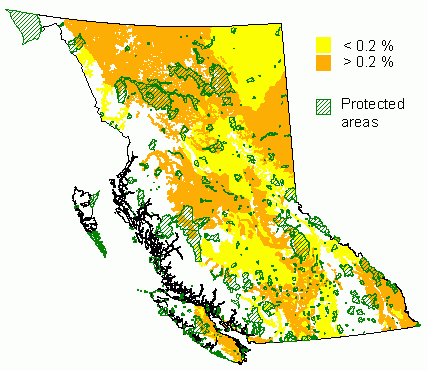Scouler willow
Salix scopulorum Barratt ex. Hooker
Introduction
Scouler willow is a shrub or small tree, growing from sea level to 3000 m altitude, though in British Columbia it is most common at lower elevations. It is a mostly shade intolerant, early to mid-seral species, forming a minor understory component in a variety of forest types. It grows on sites that are moist, though somewhat drier than those where other willows grow. It forms dense thickets, is an important browse species for livestock and ungulates, and provides ample nesting and feeding habitat for small birds and nectar for honey bees. Due to its deep root system it is suitable for rehabilitation and stabilizing steep slopes (Anderson 2001). Willow was used extensively by first peoples in a variety of ways. The supple branches were twisted into rope, and the bark was used for weaving mats and clothes (Turner 1979).
Scouler willow grows mainly in the boreal forest. The natural range of Scouler willow extends from Alaska to Manitoba and south to northern California and Montana, with scattered populations further south and east. The majority of its range is in Canada. Scouler willow occurs in most of British Columbia (Little 1976).
Distribution and Protected Areas – from Hamann et.al. 2005



Conservation Status Summary – from Chourmouzis et.al. 2009
No in situ conservation concerns were identified for this species.
Reproduction
Scouler willow is dioecious and insect pollinated. Seeds have short viability and can travel over long distances by wind. Willow stumps can resprout (Anderson 2001). Scouler willow propagates readily from cuttings (Edson 1995).
Genetic structure
Coming soon.
Resource management and seed transfer
No information available.
REFERENCES
Hamann, A., Smets, P., Aitken, S. N. and Yanchuk, A. D. 2005. An ecogeographic framework for in situ conservation of forest trees in British Columbia. Can. J. For. Res. 35:2553-2561. View online resources for this report.
C. Chourmouzis, A.D. Yanchuk, A. Hamann, P. Smets, and S.N. Aitken. 2009. Forest Tree Genetic Conservation Status Report 1: In situ conservation status of all indigenous BC species. Centre for Forest Conservation Genetics, Forest Genetics Council of BC, and BC Ministry of Forests and Range, Forest Science Program, Victoria, BC Technical Report 053. www.for.gov.bc.ca/hfd/pubs/Docs/Tr/Tr053.htm
Anderson, M. D. 2001. Salix scouleriana. U.S. Department of Agriculture, Forest Service, Rocky Mountain Research Station, Fire Sciences Laboratory (2002, April). Fire Effects Information System, [Online]. Available: http://www.fs.fed.us/database/feis/ [February 2002].
Edson, J. L. ,Leege-Brusven A. D. and Wenny D. L. 1995. Improved vegetative propagation of Scouler willow. Tree Planters’ Notes 46:58-63.
Little, E. L., Jr. 1976. Atlas of United States trees, volume 3, minor western hardwoods. U.S. Department of Agriculture Miscellaneous Publication 1314. 13 p., 290 maps.
Turner, N. J. 1979. Plants in British Columbia Indian technology. B.C. Provincial Museum Handbook no. 38. BC Provincial Museum, Victoria, B.C. 304 p.
